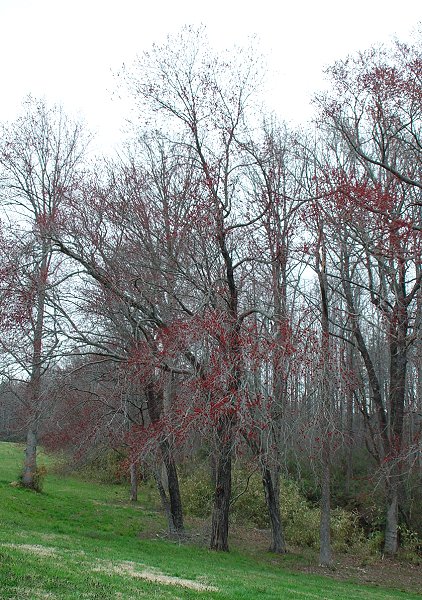Acer rubrum L.
Red Maple

Native
CC = Amb
CW = Amb
MOC = 53
© DETenaglia
Acer rubrum L.Red Maple | |
 |
Native CC = Amb CW = Amb MOC = 53 |
© DETenaglia |
|
Family - Sapindaceae Habit - Small to medium tree, monoecious or dioecious. Stems - To 15 m, usually with spreading branches. Bark of young trees smooth and gray, eventually becoming dark gray to brown and separated into long thin plates or ridges. Twigs red and shiny. Leaves - Opposite, petiolate, palmately lobed, very variable in shape and pubescence, light green-blue abaxially, dull green adaxially, to +10cm long and broad. Petioles typically with some red, glabrous to pubescent, to +10cm long.
Inflorescence - Dense clusters from lateral buds on twigs, produced before leaves. Staminate and pistillate flowers often appearing on different plants (dioecious).
Flowers - Calyces 1.4-2.2 mm long, fused only at the very base, the 4 or 5 lobes rounded at the tips, red to purplish red, glabrous. Petals 4 or 5, 1.6-2.4 mm long, orangish red to purplish red. Staminate flowers with 5-8 stamens inserted on the margin of a nectar disc. Pistillate flowers with the ovary glabrous.
Fruits - Samaras 2-4 cm long, glabrous, the wings 1.5-3.0 cm long, narrowly spreading, sometimes appearing parallel or nearly so. Dispersed after leaves mature. Flowering - March - April. Habitat - Dry to wet woods, thickets, disturbed areas. Origin - Native to the U.S. Lookalikes - None close. Other info. - This tree can be found in the southern half of Missouri. The plant is easily to recognize because of its three lobed leaves and red flowers (in the spring). Leaf shape and pubescence can be quite variable. Missouri material is currently subdivided into two varieties (var. rubrum and var. drummondii) based on leaf abaxial pubescence and fruit size. The general leaf shape is shown above in the picture. The leaves can have lobes of different lengths and variously toothed margins. All the leaves will, however, have V-shaped sinuses between the lobes. Photographs taken in Brown Summit, NC., 3-13-03, and in Vale, NC., 3-15-03 (DETenaglia); also near Labadie, Franklin County, MO, 3-26-2019 (SRTurner). |